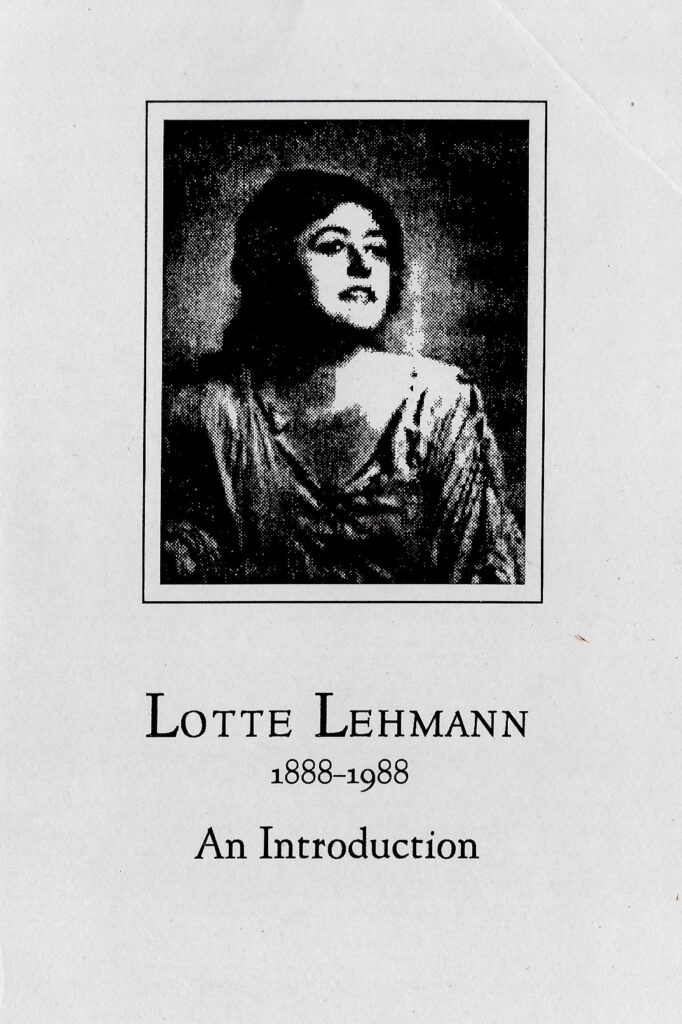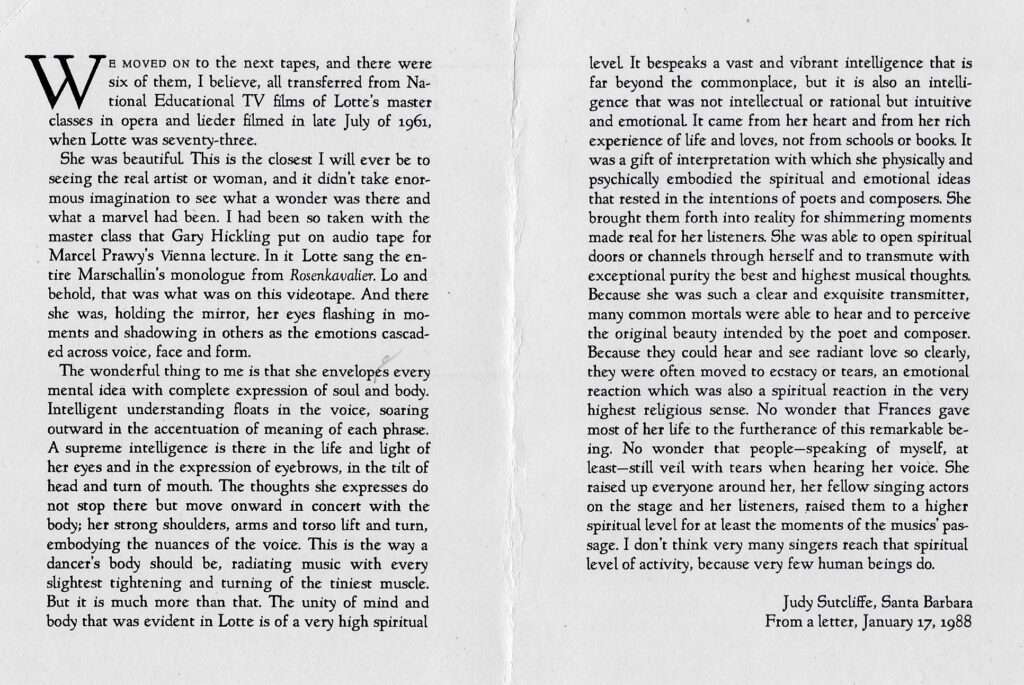“In the summer of 1987 I heard that there was to be a special performance of Der Rosenkavalier at the Vienna Opera on Lotte Lehmann’s 100th birthday, February 27, 1988, followed by a lecture the next day by Marcel Prawy, of the Opera. I decided to go. Eric Hvølboll, a Santa Barbara lawyer, volunteered to accompany me. His mother, Elizabeth Hvølboll, is a local singer who studied at the Music Academy during Lehmann times. [She sang in a master class.]
In Vienna we contacted Hertha Schuch, one of Lehmann’s friends and admirers from the “Golden Days” before the war. The three of us sat in box seats for the Rosenkavalier performance, Eric and I much awed at the whole spectacle. During intermission we admired and photographed the extensive display of Lehmann photographs, programs, paintings, and memorabilia that Marcel Prawy had assembled for this Lehmann weekend.
The opera was opulently performed. Hertha remarked afterward, however, with a sigh, ‘Lotte wasn’t there.’ Those whose memories hold her indelible image are rarely satisfied with today’s substitutes.
But Lotte was there the next day, and I was mightily surprised and overwhelmed. There was to be a lecture by Prawy. Somehow, I expected a small academic room somewhere in the opera building, and a lot of elderly people and some empty seats, it having been 50 years since Lehmann was on that stage…With that small expectation, I walked into the Vienna Opera itself, to box seats arranged by Hertha, and we looked out and up at a full house, thronged with people, 2,000 or more, all ages. There was a lively bustling of voices across the hall, I thought I spotted Grace Bumbry in one of the box seats. Marcel Prawy came on stage at 2 p.m. and lectured—talked extemporaneously, I should say, with humor and vivacity—about Lehmann for two and a half hours. His comments were interspersed with tape recordings of Lehmann’s voice. I don’t know much about sound systems and hall acoustics, but I was thoroughly shaken by the resonance of her voice as it soared, clear and vibrant, filling that opera house with its magnificence. Tears welled up in my eyes, and I could hear sniffles in the handkerchiefs across the house every time her voice rang out.
During his lecture, Prawy invited several colleagues to talk. He asked Egon Seefehlner, a past director of the Vienna Opera, to describe the indescribable, Lehmann’s voice. Seefehlner said simply that it was the only one that could make him weep.
We who are left with the legacy of her records, tend to listen to them in small living rooms, being careful not to disturb the neighbors with too much volume. There was a dimensional difference to hearing her recorded voice in the Vienna Opera, and I can only wonder at what the added dimension of her living fiber did to those who were born early enough, on the right side of the Atlantic, to hear. But I understood why all those people were there, weeping.
Seefehlner, if my understanding of German was anywhere accurate, said that he had first heard Lehmann sing when he was fourteen, and then many times after until the war. He met her again during the 1955 reopening of the Vienna Opera, the first time she returned after 1937.
He then said that his next meeting with Lehmann was in 1976 when he sat in his office at the Opera, staring in disbelief at a small bronze box on his desk labeled Lotte Lehmann. ‘All that was left of that glorious voice and presence was a mere handful of sand,’ he said. The urn of ashes had been sent from Santa Barbara for a memorial service on the marble steps of the Opera entryway, the old section which had survived the war. Her remains were buried in a place of honor in the Vienna cemetery.
As a special tribute to Lehmann, Grace Bumbry, her most famous student, came down to the stage to talk with Prawy about Lehmann’s influence as a teacher of Lieder and opera interpretation. Miss Bumbry sang ‘Auf dem Kirchhofe,’ by Brahms, twice to demonstrate the dramatic and emotional difference in presentation that she had learned from Lehmann.
After the lecture, we walked through the snow back to Hertha Schuch’s apartment, and, as if we had not had quite enough, we watched with her a half hour TV presentation on Lehmann by Marcel Prawy. This, by the way, capped a week that contained four radio programs on Lehmann as well.”



